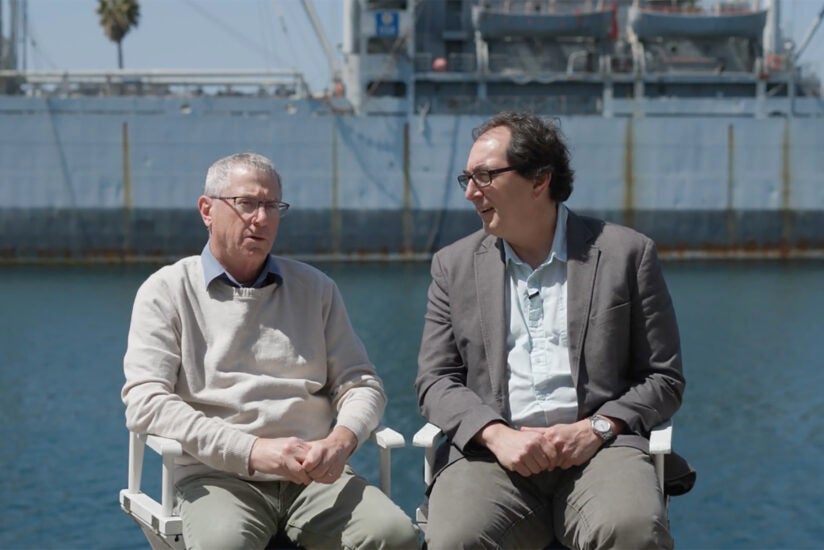
Unlocking the ocean’s secret: Natural carbon capture
Ocean-inspired methods for carbon capture hold promise for reducing greenhouse gas emissions and advancing sustainability efforts. Experts from USC and Caltech join us for a Q&A from the docks at the Port of Los Angeles.
Scientists around the world are racing to develop new methods for combating the rising levels of carbon dioxide in our atmosphere that are driving climate change and threatening the health of our planet.
 Ocean carbon capture, which involves using natural ocean processes to trap and store greenhouse gases out at sea, is one promising method. Two L.A. researchers — William Berelson of USC and Jess Adkins of Caltech — are looking to harness this technology to address the problem.
Ocean carbon capture, which involves using natural ocean processes to trap and store greenhouse gases out at sea, is one promising method. Two L.A. researchers — William Berelson of USC and Jess Adkins of Caltech — are looking to harness this technology to address the problem.
“Behind every potential solution for a more sustainable world lies a story of hard work and collaboration,” USC President Carol L. Folt said. “This promising research to reduce carbon emissions between USC and Caltech will help us all achieve a more sustainable future — starting right here in Southern California.”
We met up with Berelson, professor of earth sciences, environmental studies and spatial sciences at the USC Dornsife College of Letters, Arts and Sciences, and Adkins, the Smits Family Professor of Geochemistry and Global Environmental Science at Caltech, at the docks of AltaSea at the Port of Los Angeles — one of the largest harbors in the world and a leading gateway for international trade in North America.

How does the shipping industry play a role in climate change?
Berelson: At seaports around the world, huge quantities of goods arrive daily that feed the global economy. Those goods are transported across the ocean on container ships, cargo ships and other vessels that burn diesel fuel. Collectively, all the ships in the world are contributing about 3% of the carbon dioxide that’s being added to our atmosphere every year.
Adkins: Over 90% of the products we use in our daily lives traveled on a ship at some point. If we’re going to think about how to deal with our CO2 problem as a society, we have to be mindful of the fact that we can’t electrify all parts of the industry. Shipping is a good example of an industry that doesn’t electrify well. It’s hard to imagine ships running off batteries, even though we must, as a society, get ourselves onto renewable energy.
(Q&A continues below video)
How do carbon emissions affect our oceans?
Berelson: As carbon dioxide from the atmosphere dissolves in ocean water, it increases its acidity thus causing ocean acidification. The rising annual rate of CO2 emissions leads to a corresponding increase in ocean acidification, resulting in dramatic impacts on marine ecosystems like corals and other organisms that use calcium carbonate to build shells.
People care about corals for their beauty, but these organisms are also crucial to biodiversity and sustaining the populations of fish and other marine life that live in and among the coral communities.
Adkins: Exactly. As you acidify the ocean, you make it harder for the main components of the ecosystem to grow. But another reason we should care about ocean acidification over and above the photographic megafauna that are corals is the algae out in the middle of the ocean and far away from the coast. They are the primary producers and bottom of the marine food chain where sunlight is first turned into organic matter and then becomes food for the rest of the system, humans included.
How does the ocean naturally capture carbon?
Adkins: The planet has been capturing carbon for billions of years. As the ocean absorbs excess carbon, the CO2 reacts with calcium carbonate, or limestone, that naturally occurs at the sea floor — this reaction makes the neutral salts of bicarbonate and calcium ions.
Berelson: The natural reaction that happens in the ocean is exactly what happens when you treat an upset stomach. The analogy we like to use is that when you have excess acid in your tummy, you take a little antacid tablet, which is effectively ground up calcium carbonate, to neutralize the acid.
What are you working on now?
Berelson: An idea came about during our research on how the ocean naturally mitigates excess CO2. We discovered that if we could accelerate the dissolution of limestone, it could be a way to mitigate CO2 at a larger scale. We’re developing a startup company that could one day build machinery that would allow this reaction to happen at a fast enough scale and at the right quantity to make a greater impact on CO2 reduction.
Adkins: Right. Although the ocean naturally captures carbon, it does so at a slow rate. We want to find ways of speeding up the neutralization of that extra CO2. All we have to do is follow the natural process of what happens when, say, volcanoes erupt and release CO2 into the atmosphere.
What inspired this collaboration?
Adkins: We’ve known each other for decades as friends in the field and have always talked about finding something to work on together. But it was our shared concern about ocean acidification and the idea that we might be able to make a breakthrough that brought us together to think about joining labs.
Berelson: True, we initially bonded over our common interest in chemical oceanography. That and all things having to do with major league baseball.



